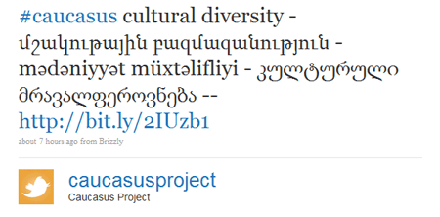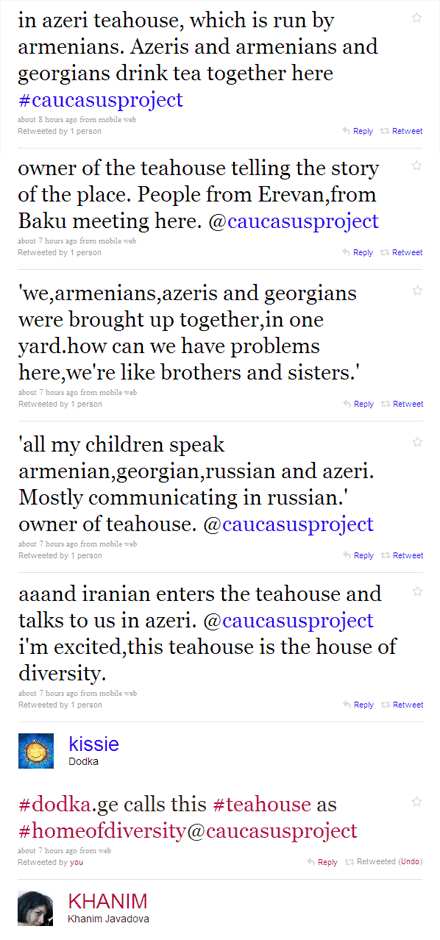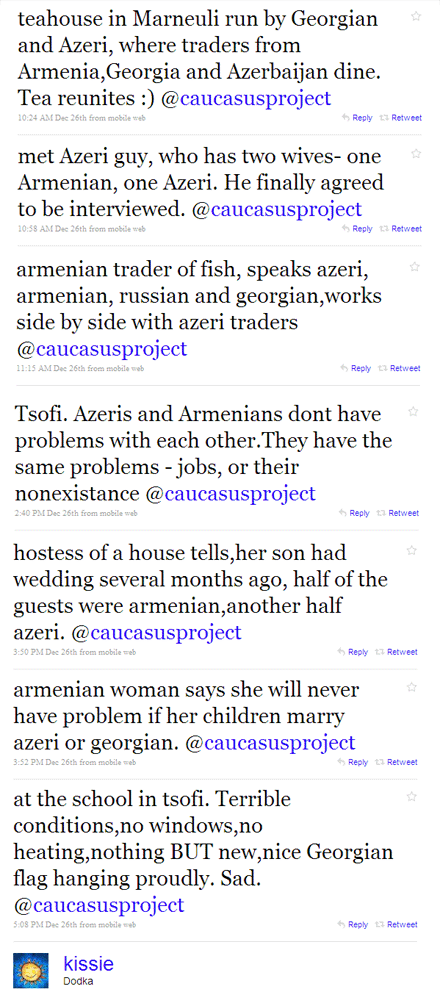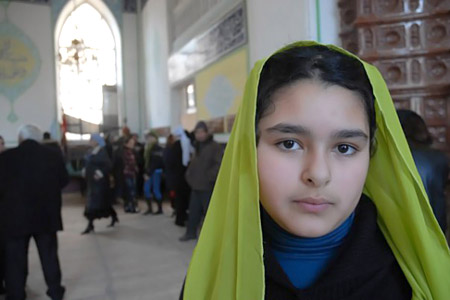This post is part of our special coverage Caucasus Conflict Voices.

Ethnic Armenian, Tsopi, Georgia © Onnik Krikorian
Following a recent collaboration between Flying Carpets and Broken Pipelines blogger Arzu Geybullayeva and Global Voices Online's Caucasus editor, an online project using new and social media to overcome negative stereotypes in the South Caucasus entered a second stage last week when two blogging journalism students, Vusala Alibayli and Khanim Javadova, joined a Georgian blogger and Global Voices Online author Dodi Kharkheli aka Dodka in the initiative.

The project aims to promote positive examples of ethnic groups coexisting peacefully in a volatile region riven with frozen conflicts in an attempt to provide an alternative to what is usually a partisan local media that not only self-censors, but also spreads misinformation and negative propaganda. As with the first stage of the project, the focus was on ethnic Armenians and Azeris living in Georgia.
Unlike Armenia and Azerbaijan proper, still effectively at war over the disputed territory of Nagorno Karabakh, the two groups live side by side. Conducted in cooperation with Transitions Online, Steady State sets the background [AZ/EN/RU/SP].
Situated within neighboring Azerbaijan, but inhabited mainly by ethnic Armenians, Karabakh was one of the first of many simmering conflicts which accompanied and perhaps even ushered in the collapse of the former Soviet Union. Over 25,000 were killed, a million people on both sides were forced to flee their homes, and Azerbaijan lost 16 percent of it territory by the time a 1994 ceasefire agreement was signed. Regional analysts and the international community, however, fear that the war might one day resume.
Various attempts to broker a final peace agreement have since faltered with nationalists and political forces on both sides of the ceasefire line maintaining that the two ethnic groups can never live side by side together again. Subjective perceptions and interpretations of history have only added to the stalemate leading to the sad reality that neither side is willing to compromise. Ironically, however, such entrenched positions often appear absurd given the peaceful coexistence of Armenians and Azeris in Georgia.
[…]
Indeed, as others point out, Armenians and Azeris are quite able to coexist together outside of the conflict zone and actually have more in common with each other in terms of culture, tradition and language than many other nations living in the same region. […]
In fact, as a second post detailing visiting a teahouse [EN/RU] where all the ethnic groups of the South Caucasus gather notes, the cultural links between Armenians and Azeris in Tbilisi, the Georgian capital, have long been there, albeit often overlooked by the media or nationalists opposed to any talk of compromise or peace.
It was perhaps only appropriate that the route for a return visit to an Azeri tea house run by ethnic Armenians in the old part of Tbilisi took us past a statue of the renowned ethnic Armenian filmmaker Sergei Parajanov. Like other Armenian cultural icons such as Sayat Nova, an 18th century troubadour who wrote songs in Armenian, Georgian, Persian and especially Azerbaijani, Parajanov belonged more to the Caucasus than any one nation and it was perhaps for this reason that he remained in his native Tbilisi for most of his life. He moved to Yerevan just two years before his death in 1990.
Dodka also tweeted her observations.

After visiting Marneuli and Tsopi, two locations where ethnic Armenians and Azeris also coexist together, Dodka again tweeted the same observations [AZ/EN/RU/SP].


School, Tsopi, Georgia © Onnik Krikorian
In the village of Tsopi itself, Khanim Javadova provided more details about the problems facing the local school where both ethnic Armenians and Azeris study together.
There is no running water and the doors of all the classrooms have many holes, but few are used because of their condition. The school’s director, Latifa Ibadova, says the Georgian Ministry of Education promise to repair whole school in 2011. There is electricity in the village, but no gas and wood is used for hearing. This winter the school received money from the government to buy two lorries of wood and gasoline.
Another problem of pupils is that of textbooks. From this year pupils must buy books in the Georgian language. Previously, textbooks had been provided free of charge, but now cost 6-15 Lari even though many residents of Tsopi cannot speak Georgian. This prevents them from later finding work. Yet, despite these difficulties, the pupils of school are on good terms with each other. Armenians know the Azerbaijani language and Azeris know Armenian.
Meanwhile, Vusala Alibayli once again touches upon the issue of the two groups living in the same location despite hostilities between Armenia and Azerbaijan, and the negative perceptions of the other side in both countries.
Mustafa says that 60-70 percent of the village is ethnic Azeri and then comes the ethnic Armenians. There are places where both live together side by side.
“Until now we didnt have any problems among Azeris, Armenians and Georgians. We are going to each other’s weddings and holidays. Even when I was talking with an Armenian in his own language, he replied in Azerbaijani. There are no problems, we are united and will remain like this. Other issues are political and not related to ordinary people. I am very pleasant with Armenians in Tsopi and other villages.”

Ethnic Azeri, Mosque, Tbilisi, Georgia © Onnik Krikorian
All of which was food for thought for many, and not least Dodka who also lives in the same country.
I am a citizen of Georgia.
I was born and brought up here, never leaving its borders until two years ago. I have heard about the conflict between Armenia and Azerbaijan, but I have never felt it.
Why?
Well, everyday I see kids playing in the yard. Some of them are ethnic Georgians, some Azeri, and some of them are Armenians.
[…]
I hope to see peace in South Caucasus.
If people from Georgia, Azerbaijan, Armenia can coexist here, then surely they can coexist anywhere.
Over the coming days and weeks there will be more such examples using new media and social networking tools and stories, photos, and video as a continuation of the brief cross-border exercise undertaken in September. Follow it on Twitter @caucasusproject.
This post is part of our special coverage Caucasus Conflict Voices.







9 comments
Dear Onnik,
Its been a great pleasure reading this post and I look forward to reading more.
Its such a joy to hear that we- Azerbaijanis, Armenians and Georgians- live together and talk to each other- there is no hatred and mutual understanding.
Great job! Well done!